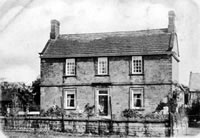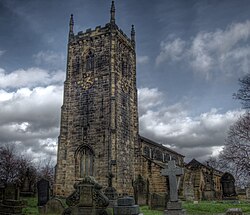Normanton, Yorkshire
| Normanton | |
| Yorkshire West Riding | |
|---|---|
 High Street, Normanton | |
| Location | |
| Grid reference: | SE385225 |
| Location: | 53°41’49"N, 1°24’58"W |
| Data | |
| Population: | 20,872 (2011) |
| Post town: | Normanton |
| Postcode: | WF6 |
| Dialling code: | 01924 |
| Local Government | |
| Council: | Wakefield |
| Parliamentary constituency: |
Normanton, Pontefract and Castleford |
Normanton is a town in the West Riding of Yorkshire, standing north-east of Wakefield and south-west of Castleford. At the time of the 2011 Census, the population was 20,872.
History
Foundation
The Domesday Book gives information on 'Norman-tune' as:
In Normantune there are 10 carucates for geld, which 5 plows can plough. 2 thegns had 2 manors there T.R.E. Now, in the King's hand there are 6 villeins there, and 3 bordars, a priest, and a church, with 3 ploughs, 3 acres of meadow. Pasturable wood (land) 6 furlongs in length and 1 in breadth. The whole of this land lies in the soc of Wachefelt, except the Church. T.R.E. it was worth 12s: now (it is worth) 10s.[1]
Normanton was originally surrounded by a moat, and in Norman times was the site of an enclosed settlement (chosen for its strategic view points across the surrounding area). Archaeological evidence points to Haw Hill (or How Hill), an eminence as a probable Norman defensive strategic mound once reinforced by a wooden palisade.[2] The evidence of a Norman motte-and-bailey fortification at the town, and the name, is likely evidence that Normanton's name derived from the substantial Norman presence in the area. An alternative derivation may be from "Norsemen's town" (Normanna tun), but there is no evidence of the name before the Norman fortifications.

One of the earliest buildings to survive within the village is Hanson House.[3] This is set back from the church and has a timber frame construction. The building was constructed in the mid-15th century, with a later wing added in the 18th century. A fire has damaged the building, which is being restored and modernised.
A grammar school was founded in Normanton by John Freeston (now the 'Parish Rooms'..later moved to the site of the, Normanton Junior School on Church lane) in 1592,[4] but the town remained very small until the railways came.
Industry
George Stephenson's North Midland Railway from Derby to Leeds was soon followed by the York and North Midland Railway from York and then the Manchester and Leeds Railway from Manchester. The Leeds and Manchester lines crossed a 51 miles stretch across the Pennines and at the time had the world's longest railway station platform at Normanton - a quarter of a mile long. The station was, for the next ten years or so, the most important in Britain, employing over 700 people, as 700,000 passengers a year passed through. Queen Victoria stopped over here in The Station Hotel. In 1871 Dom Pedro, the Emperor of Brazil, visited Normanton with his Empress and gave his name (in a slightly altered form) to the Don Pedro colliery at Hopetown.
The railways carried industrial loads of the area's coalmines and brickworks, although most of this was lost during the 1950s and 1960s with the last remaining operational brickworks eventually closing in the mid-1990s. There were three brickworks in town, all within the small area of Newland, which has an abundance of clay. A fourth works was founded in the 1890s by a Thomas Kirk from Nottingham, who had heard rumours that Normanton was rapidly turning into an important junction on the railways. Both Kirk and his sons used their life savings and formed the Normanton Brick Company at nearby Altofts which is still in operation today.
The coming of the railways enabled the locally mined coal to be sent across the country. Demand soon outstripped supply and many more shafts were sunk to reach the coal seams under the town. Today roads in the area of the former colliery retain the name. At their peak the Collieries employed over 10,000 men, most of whom wanted to move themselves and their families to Normanton. The town enjoyed a boom period with more mines opening and more shafts being sunk in order to meet the increasing demand for coal until, by the mid-1970s, most coal seams in the Normanton area were worked-out.
Decline
Normanton's last mines closed in the 1970s, along with many of the nation's collieries. The Miners' Strike of 1984-1985 still affected many families in the area, as Normanton colliers had worked in pits in neighbouring towns.
The area once occupied by the St Johns or Newland colliery is now part of the controversial Welbeck landfill site which has been the subject of both local and national media attention since its development as a toxic tip. The site attracted so much negative attention that the group Residents Against Toxic Scheme (RATS) was established to halt planning permission for the disposal of toxic chemicals at the site, claiming the scheme was an extreme health hazard.
Normanton suffered decline in the years following the loss of the mines. The railway station, once the most important in Yorkshire, was in such a state of neglect and disrepair that the decision was made to demolish it in 1986; the section of railway line between Goosehill Junction and Crofton Interchange were lifted the year after. Very little now remains of Normanton's railway and mining heritage.
Modern Normanton
Normanton has become a growing commuter suburb of Leeds and its satellite towns, with relatively cheap housing and efficient transport links. The town is still accessible by Normanton railway station, and is currently served by an unmanned island platform station with regular trains to Leeds, Castleford, Wakefield and Sheffield Meadowhall Interchange.
The addition and expansion of the Eurolink Industrial Estate at Junction 31 of the M62 attracted national and multi-national corporations to locate their distribution depots to Normanton: the railways once saw the town as a key strategic location and that it remains, centrally located within Great Britain, and served by three major motorway networks: the M62 linking Manchester to Hull (west to east); the M1 linking Leeds to London; and the new link between the M62 and the A1(M) at nearby Ferrybridge.
Places of interest
Normanton church

All Saints, is the Church of England Parish Church. It is believed to have stood since at least 1256 and is built in the perpendicular style.
Newland
The Newland estate was a small township on the outskirts of Normanton and lies on the north bank of the River Calder. Existing since 1213 when it was established by King John as a preceptory of the Knights Templar, until the order's dissolution in 1256, when it passed to the Knights Hospitaller, in turn dissolved by King Henry VIII, whereupon the lands fell to the Crown. Newland was once held by the Levett family, and William Levett, who was lord of the manor, was admitted tenant of the Knights Hospitallers on 2 October 1447.
The estate changed hands of ownership a number of times after King Henry VIII sold the land in 1544, with final ownership landing on The Warmfield Company Limited in 1926, who ran brickworks until the mid-20th century.
Newland today is kept as a nature reserve, with the remains of the Estate overgrown with shrubs and plant life. A small fishing area just outside the Newland Estate is used by local fishermen.
Sport
- Cricket:
- South Normanton CC
- Normanton St Johns CC
- Football:
- A S Normanton FC
- Normanton Athletic Juniors
- Rugby League:
- Normanton Knights
- Featherstone Rovers (professional), based in nearby Featherstone.
On film
The old Normanton brickyard, off of the A655 Wakefield Road, was used in the late-1990s as the fictional setting of a murder in the ITV series A Touch Of Frost.
Outside links
- Local Community Page
- Town Football Team Newfield AFC
- All Saints Normanton Football Team
- Houses of Knights Hospitallers
References
- ↑ A History of Normanton & District, R.H. Pestell, 1973
- ↑ Normanton, Its Name, History of Normanton, wakefield.gov.uk
- ↑ Hampson, Walter. "History of Normanton". wakefield.gov.uk. http://www.wakefield.gov.uk/CultureAndLeisure/HistoricWakefield/People/WalterHampson/HistoryOfNormanton/04Families.htm.
- ↑ Pastell, Ibid.